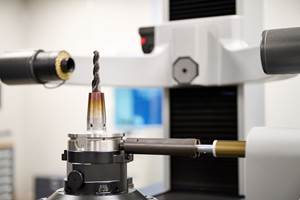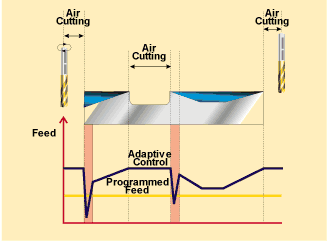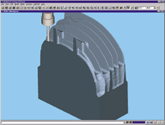Overriding The Skills Shortage
With experienced operators in short supply, this shop developed a software solution to compensate.
Share




Hwacheon Machinery America, Inc.
Featured Content
View More




The ears, reflexes and fingertips of an experienced machinist make up the most effective system there is for feed rate optimization.
But there is a problem with relying on that system. As the number of experienced machinists declines, so does the consistency and efficiency of NC cycle times.
Cam-Tech Inc., an aerospace-industry contract shop in Dallas, Texas, knows this problem very well. The shop employs CNC operators across a range of skill levels. And though capable employees who are willing to learn are available, employees with years of experience overseeing complex milling jobs often are not. As a result, cycle time for the same NC program can vary considerably depending on whose hand is on the feed override knob.
The shop investigated a variety of possible solutions. One was to try to optimize cutting parameters before the job got to the shop floor using CAM software capable of varying the feed rate based on the amount of stock encountered. This software often did work well, but the programs it produced generally still left room for manual override at the machine tool to improve the process further. Also, the data input this software required proved time-consuming. Programmers spent considerable time equipping the software with specs and performance information related to the specific tooling and machines the shop uses.
Another possible solution was an add-on unit for the control that varied feed rate based on spindle load. This accessory looked promising, but only as far as it went. For Cam-Tech, it's not just load that determines when an operator changes the feed rate—chatter is also significant. A problem the shop had with the add-on unit is that it didn't have ears.
So the shop created its own solution. Its engineering staff (and one member in particular) wrote control software for recording all of an operator's overrides. Storing the overrides in an event file allows them to be "played back" in conjunction with the NC program the next time the job is run. That means an experienced machinist only has to run a given job one time. After that, all of the fine-tuning can be reproduced automatically no matter what operator is at the machine.
Though the approach may seem simple, this software's method is particularly well-suited to the aerospace industry. NC programs here are "bought off" documents that undergo quality review and approval just as if they were hardware tools. As a result, it can be difficult to make small, continuous improvements to a program based on its performance on the shop floor. Changing just the speed and feed in the code would result in a new program requiring new approval. However, speed and feed changes resulting from manual override—which doesn't touch the NC code—are fair game. Thus the override software can make it far more practical for an aerospace shop to improve its speeds and feeds as warranted.
The software will soon be available to other shops, and Cam-Tech's former owner Bill Allen says he expects companies involved in aerospace machining to make the most likely prospects. Mr. Allen is the former owner of Cam-Tech because he sold his shop to start the company that will bring the software to market, Manufacturing Science Technologies (also in Dallas). For now, he continues to manage the shop on the new owner's behalf.
Like almost any successful shop, this one doesn't have enough highly experienced operators that it can put one on every job it takes on. That's why the ability to record and re-run these employees' overrides made the shop significantly more productive.
What Does A Good Cut Sound Like?
Operators who intuitively know the answer to this question acquire this instinctive sense through experience, Mr. Allen says. Watching operators at various experience levels has shown him that the less-experienced ones tend to make two common mistakes, both of which stretch out the cycle time.
The first mistake is to overreact when the sound of the cut suddenly turns loud by backing off the feed rate too much.
The second is to keep the feed rate too low for too long—as when the operator over-cautiously runs out the rest of the program at the reduced feed rate instead of turning it up again as soon as the profile of the cut changes. In terms of machine time, this high level of caution can be costly indeed.
Cam-Tech investigated one other approach to reducing and standardizing cycle times. This one was a procedural change. Programmers more carefully tailored cutting parameters to individual cuts. In other words, programmers performed a role similar to optimization CAM software but without the software's setup time.
The problem with this approach was that it traded one source of delay for a potentially more serious one. Experienced programmers are in short supply just as experienced operators are. Increasing the amount of time required to program each job simply increased the chance that bottlenecks in the programming area would keep work from getting to the shop floor. And even when a programmer did strive to optimize speeds and feeds, an operator with a hand on the override knob often could still improve the cycle time further. This made it clear to the shop that if fine-tuning speed and feed rate was a function best performed by a human expert instead of an automatic system, then the operator—not the programmer—was the human in the best position to carry out this work.
The override software can put this fine tuning almost entirely in the operator's hands. It can also let a shop better leverage the skill of an operator who performs this role. In addition to ensuring that the experienced operator only has to run the job one time, the software also provides an incentive for that operator to get feed rates as close to optimum as possible. The best cycle time that can be achieved without undue strain on the tooling or machine can stand from that moment on as the level of efficiency at which the job will always be run.
Parts that illustrate the benefit of the software are shown on page 96. Cam-Tech has machined these aluminum parts since well before the override software was implemented. The curving part, nicknamed the "twisted sister," is machined from an aluminum block. The part supports the vertical winglet on the wing tip of a Gulfstream V business jet. With an event file of carefully applied override values, this part is now machined in about 30 percent less time compared to the average cycle time the shop was used to seeing.
The larger parts, side fittings for Boeing 767 aircraft, are machined from forgings. Cycle time improvement for these parts is about 20 percent, which translates to more than 4 hours of machining time saved.
And Mr. Allen says he has seen one more side benefit of using the software. Less-experienced operators ascend the learning curve faster, he says. What a good cut sounds like is much more clear to them now. As a result of running programs that have already been fine-tuned, operators get into the habit of hearing that sound.
Openness In Action
Mr. Allen calls the override software "Dynamic Feed Control." He had the idea for the software years ago, he says, but the state of CNC technology at the time left no practical way to implement it. How could an external third-party software program interact with an NC program sealed inside the CNC?
The answer, of course, came in the form of more open controls. In late 1999, he attended a machine tool builder's demonstration of the High Speed Serial Bus (HSSB) technology now available on Fanuc controls. The feature allows an external, non-proprietary PC to communicate with the CNC while the program is running. "I saw that, and I knew we could make the feed override idea work," Mr. Allen says. For help developing the software, he turned to Tony Fezio, an aerospace-industry programmer (the computer kind as well as the NC kind) who is now head of systems development for the new company.
In addition to Fanuc, the override software can be used on other controls offering a basic level of openness, including MDSI and Siemens Acramatic. It can also be used with older Fanuc controls for which the HSSB capability has been added via a retrofit card. Describing the level of openness required, Mr. Fezio says, "The minimum we need is a block in the CNC's ladder logic that lets our software tell the control, ‘When I throw this switch, start taking instructions from me.'"
The software works by sampling feed and speed override settings every tenth of a second. It samples the program block number, too. The resulting event file essentially becomes an override program separate and distinct from the NC program to which it corresponds. For further refinement, this event file can be edited manually.
When the software runs the event file to play back the overrides, it does so without taking total control over the override functionality. The operator isn't locked out—the override knob is still active. When it's used, the knob works as a multiplier over the event file's override value up to the maximum possible override of the control (which may be more than the knob itself permits—see the shaded box on page 93.)
Overall Effect
Cam-Tech now stores the event files on the same DNC server as the NC programs. For those jobs for which an event file has been created, it could be said that two different programs are now sent to the CNC.
One program was created at a CAD/CAM station. It defines the tool paths.
The other program—the override event file—was created on the shop floor at the CNC. It defines the fine-tuned speed and feed rate values. This information is no longer lost each time the job is finished.
In other words, what the override software does is let the experienced operator record some of that experience so others can make use of it later.
The software turns the operator into a programmer in his own right.
Related Content
Simulation and Tooling Secure High-Value Work
Simulation software and careful attention to tooling parameters have enabled Major Tool to take on ambitious projects with its complex machinery.
Read MoreERP and Process Changes Increase Shop’s Revenue 64% YoY
Implementing ProShop has led to a massive process overhaul at Marzilli Machine. From 2020 to 2021, revenue increased 64% without capital investment.
Read MoreShop Moves to Aerospace Machining With Help From ERP
Coastal Machine is an oil and gas shop that pivoted to aerospace manufacturing with the help of an ERP system that made the certification process simple.
Read MoreHow this Job Shop Grew Capacity Without Expanding Footprint
This shop relies on digital solutions to grow their manufacturing business. With this approach, W.A. Pfeiffer has achieved seamless end-to-end connectivity, shorter lead times and increased throughput.
Read MoreRead Next
Find Your Feed Rate On The Fly
Truly 'adaptive' motion control is now a retrofit option for a wide range of CNCs. This job shop uses the technology to reduce tooling costs and cycle times
Read MoreThe Case For Verifying And Optimizing Tool Paths
Two very different shops illustrate the potential value of software that works between the CAM software and the CNC.
Read MoreRegistration Now Open for the Precision Machining Technology Show (PMTS) 2025
The precision machining industry’s premier event returns to Cleveland, OH, April 1-3.
Read More


























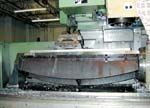
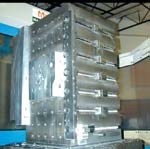
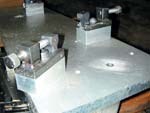
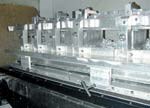

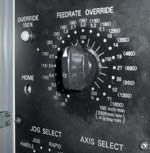
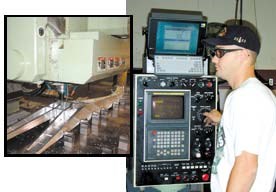











.jpg;maxWidth=300;quality=90)








